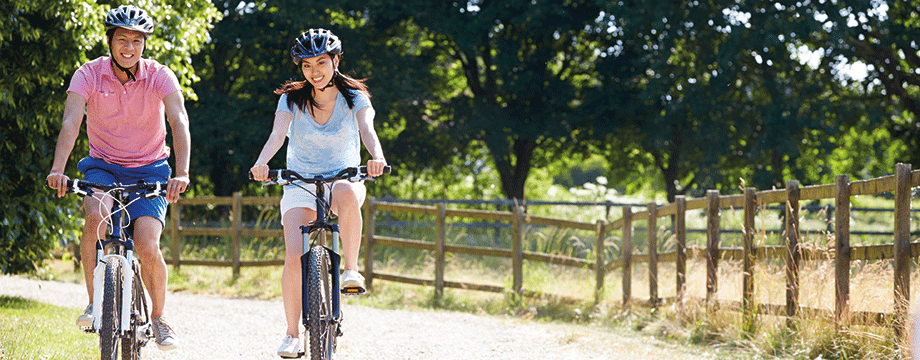Cycling Proficiency

Try these expert tips to improve your cycling performance and get the most out of your next bike ride
Cycling is a fantastic form of exercise for keeping fit and enjoying the outdoors. However, in order to improve your performance and prevent injuries, strength exercises are a must. Here, Joe Hewitt, an EIS strength and conditioning coach, who is working with British Cycling, suggests some simple exercises to try at home. The only equipment you will need is a kettlebell. If you are a beginner you might want to start off with an 8kg weight.
“These exercises will strengthen the muscles around the hip and knee whilst working the upper body and improving postural strength,” says Joe. Practise these exercises a minimum of twice a week. Start with six to eight repetitions, with the aim of progressing to 15 to 20 reps.
Goblet squat
Stand with your feet shoulder-width apart, holding the kettlebell close to your chest. Squat down, imagining that you are trying to sit down on a chair behind you. Make sure you don’t allow the kettlebell to pull you forward – stay tall and strong. Drive your knees out as you squat down.
Lateral squat
Stand with your feet spaced out quite wide, hold the kettlebell close to your chest, and squat down towards your left foot. Then, come up and squat down to the right. As with the goblet squat, imagine that you are going to sit down on to a chair. The aim is to see how close you can get the kettlebell to the floor.
Stiff leg deadlift
Stand with your feet shoulder-width apart, holding the kettlebell close to your chest. Then, lean forward and lower the kettle bell to the ground, making sure you keep your back straight, pushing your bottom out and pushing your weight through your heels. You should feel a stretch along your hamstring as you perform the exercise. There is very little bend at the knee – it’s more about moving from the hip. Look straight ahead in order to keep your neck in line with your back.
Front plank
Begin by getting into a press-up position. Bend your elbows and rest your weight onto your forearms instead of your hands. Make sure that your elbows are directly under your shoulders and keep your back straight. Your body should form a straight line from your shoulders to your ankles. Squeeze your glutes and engage your core by sucking your belly button into your spine. Initially hold the position for as long as you can without losing good form. Aim to build up to between a minute and two minutes.
For more tips on improving your cycling performance, visit www.britishcycling.org.uk
Set some goals
“Research proves that HIIT (High Intensity Interval Training) is far more beneficial than steady state cardio,” says Tom Wanless, a trainer with Speedflex (www.speedflex.com). “For anyone looking to improve their fitness, performance times and other specific goals, a training plan is vital as this will help you to stay on track. Alongside this, think of what the ‘goal setting’ is and use FITT (frequency, intensity, time and type) meaning how often, what intensity you’ll be pushing your body to, for how long, and what type of exercise, to work this out. SMART goals are also a good guideline. Use this when designing your programme, think: Specific, Measurable, Attainable, Realistic and Time bound.
“But remember it’s important to add variety to your workouts, as it will not only keep your body guessing but also help to keep you from plateauing. Doing the same exercise routine or class every day can become boring and make you lose interest. Instead, mix it up. Training 3-5 times per week will help you to improve no matter what your goals are. Mix the sessions up with runs, weight training, Speedflex sessions and cycling to keep it fresh.”
Be prepared
Andrew Oldham, general manager of Merlin Cycles, (www.merlincycles.com) offers some top tips for getting the most out of your next ride.
Nutrition and hydration
Try to eat little and often throughout your ride. Make a mental note of where the big climbs of the ride are, and remember to eat with them in mind. Check you are hydrated before leaving the house. Setting out dehydrated is dangerous, especially if you are planning to complete a long ride.
Time saving
A bike ride’s not a bike ride if it doesn’t involve a stressful dash around the whole house beforehand. Get your bike, shoes and helmet ready the night before and leave them by the door.
Breathing
It is easy to get carried away and take shallower, faster breaths but it’s worth trying to calm down and control it. Fast, shallow breathing can put you under more stress and increase your heart rate.
Read previous Your Outdoor Living articles here...
Read articles from our latest issue here...